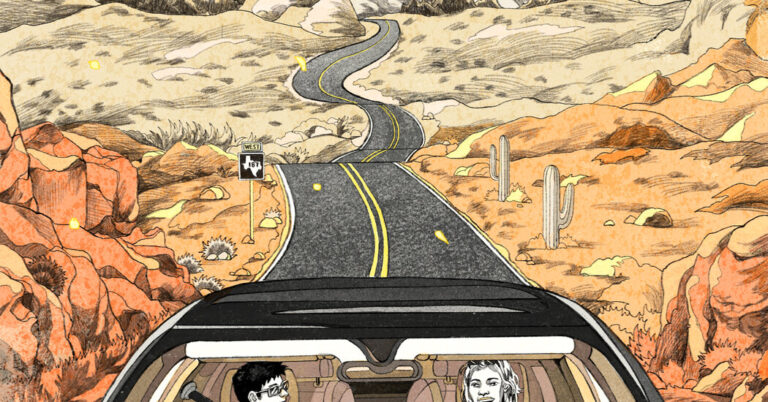Planning an accessible road trip is becoming easier for people with disabilities. There are more resources being created by and for the disability community, and the tourism industry is beginning to recognize the value of accessible travel. As a disabled, chronically ill, neurodivergent person, I travel every year and have learned a few tips and tricks along the way.
Car rental
Most major car companies offer adaptive driving devices for their vehicles at no additional cost. Enterprisefor example, offers hand controls, left foot accelerators, pedal extenders and spinner knobs to facilitate steering. Budget can provide hand controls, spinner knobs, panoramic mirrors, swivel seats and transfer boards. Be prepared to request adaptive devices at least three business days in advance.
For a wheelchair accessible van with a ramp or lift, rent from a mobility company such as BraunAbilityone of the largest manufacturers of wheelchair accessible vans in the country, with rentals in multiple locations. MobilityWorksan accessible vehicle and adaptive-equipment dealer, has rental locations in 34 states. AccessibleGO, which offers a one-stop shop for adapted rental cars and wheelchair-accessible vans, has agreements with 100 wheelchair van rental locations nationwide; request a quote on their website. For accessibleGO rental cars, you can request hand controls and spinner knobs at checkout.
Route planning
You can use Google Maps, Waze and MapQuest for preliminary accessibility research using photos and street views. Google Maps provides directions for some wheelchair-accessible pedestrian and transit routes.
Sites like Road trips and fork can plot an entire itinerary. Although these websites are not disability specific, they are invaluable tools. (Roadtrippers have a wheelchair accessible check box in the search function.) You can filter by types of destinations such as national parks or museums, and search for hotels and campgrounds. Furkot allows you to enter how long you want to drive each day, whether you want to travel on Interstate highways or take more scenic roads. The app will determine the best route and length of time between stops, and suggest where to stay overnight.
Finding accommodation
While hotels and other accommodations are required to comply with the Americans With Disabilities Act, many hotels do not meet all accessibility requirements. Most booking sites list hotels with accessible rooms for those with mobility, hearing and vision needs, but this information is not always verified. Do more research on review sites and look for pictures. Hyatt, Marriott, Hilton, and Fairmont hotels offer allergy-friendly and scent-free rooms in some locations. Call the hotel to verify accessibility and to make sure a specific room is reserved for you.
Vacation rentals are generally not required to be ADA compliant, but some provide accessibility information. Airbnb recently launched a adapted category with accessibility search features and homes scanned for accessibility. Check the photos and contact the host for more information. Some hosts will make accommodations, such as changing cleaning supplies or moving furniture, but document your request using the in-app messaging system so customer service can help if you run into issues .
Roll the World is an accessible travel agency offering bookings at over 3,000 verified accessible hotels in the United States. Hotels are personally reviewed by trained reviewers; only those that meet the criteria are listed. Sign up as a disabled traveler or a companion and complete a personal profile that includes options for different disabilities and accessibility needs. The site will provide listings that match your profile with partial, sufficient and outstanding match options.
Food and medicine
There are various options to keep food or medicine cold while traveling. Electric coolers can plug into your car’s 12-volt outlet, but pay attention to the type of cooling mechanism — cheaper versions are often thermoelectric and will only cool to about 30 degrees below ambient temperature ( if it’s 70 degrees in the car, it will cool down to 40 degrees). Compressor coolers are more expensive but maintain normal refrigerator temperatures.
Many hotels provide mini-refrigerators. If you know you’ll be stopping at a place with a refrigerator most nights, put large ice packs and supplies in a cooler, then add another insulating layer like a cooling bag. It keeps everything cold for days at a time.
It’s also a good idea to travel with a single-burner cooktop — electric for indoor use, or propane for use in rest areas and campgrounds — and a camp mess kit so you can cook meals safely.
Some of the best apps to find food, restaurants and grocery stores that cater to dietary needs are fig for allergy-specific options, Happy Cow for vegan-friendly options and Find Me Gluten Free for celiac-safe areas. Add your favorite options to the route planning app so you know where to stop.
Search activities
In addition to the apps mentioned in the route planning section, state and local tourism organizations are great resources for accessible destinations.
National parks and monuments, which are required to meet federal accessibility guidelines, typically have visitor centers and recreation areas with accessible features. Each park website with information, as well as programs and services within the park. While accessibility varies, you’ll typically find information on wheelchair-accessible trails and campsites, tactile and audio features, assistive listening devices, and American Sign Language interpreters. .
In state parks, accessibility features may not be uniform, but you can usually find some information on each park’s website.
Apps like AllTrails list wheelchair-friendly trails across the country, but the information may not be verified, so contact the park or land manager for verification. Among the parks with remarkable accessible paths are Redwood National and State Parks, North Cascades National Park, Badlands National Park, and Great Smoky Mountains National Park.
Syren Nagakyrie, the nonprofit’s founder Hikers with disabilities and the author of “The Disabled Hiker’s Guide to Western Washington and Oregon” and “Disabled Hiker’s Guide to Northern California,” among other guidebooks, leads group hikes and conducts assessments across the United States.
